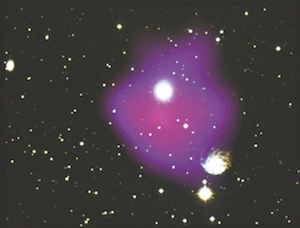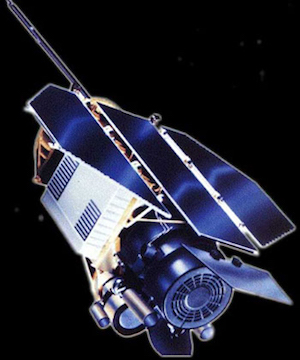Dark Matter Hunt Heats Up

Image credit: NASA
Hot X-ray emitting gas (shown in purple) was discovered by the ROSAT satellite to be present in the group of galaxies called NGC 2300. The presence of the gas provides evidence for the existence of dark matter.
The mystery of dark matter just deepened. A new report takes a look at a huge mass of dark matter (equal to about the mass of about 20 trillion Suns) located in a small cluster of galaxies. Dark matter isn't visible, and scientists can't explain what it is.
A large quantity of dark matter was found using the ROSAT X-ray satellite. ROSAT detected a gigantic cloud of very hot gas in the empty space between two galaxies. This was a very unexpected place to find this gas. Scientists detected the hot gas because it gives off X-ray radiation. This cloud is a surprise, because its great heat should have made the gas quickly dissipate.
The existence of the hot gas cloud can only be explained by the existence of a gravitational force to hold it in place. Only dark matter could do the job without being seen, explains Richard Mushotzky of NASA'S Goddard Space Flight Center.
To hold the gas in place, a very strong gravitational force is needed. The gravity caused by the visible matter in the galaxy cluster isn't nearly strong enough. To create enough gravity, there must be 30 times more matter present than what can be seen. This unseen matter is dark matter. The normal matter ROSAT observed is just a small fraction of what's really there.
If there is that much dark matter compared to visible matter throughout space, then dark matter could determine the fate of the universe. Its gravity could be enough to someday reverse the direction of matter and energy flung out by the Big Bang and pull the universe back together into a "Big Crunch," say some researchers.

Image credit: Max-Planck-Institut für extraterrestrische Physik (MPE)
An artist's rendering of the ROSAT Satellite
In 1970 astronomer Vera Rubin also believed dark matter existed. She studied the rotation rate of stars in the Andromeda galaxy and found that it just didn't make sense. Scientific models predicted stars farther from the center of the galaxy should revolve more slowly than stars closer to the center. However, this is not what is observed.
The simplest explanation is that matter is a lot more evenly spread through the galaxy than it appears. This would cause the force of gravity to be fairly equal throughout the galaxy. Therefore, dark matter must be what is creating the gravity that is tugging at these stars and keeping them in the galaxy.
Despite the new ROSAT discovery and its enormous implications, scientists haven't been successful in figuring out exactly what dark matter is. Some think it might be a type of subatomic particle that has mass but only interacts with normal matter through gravity. These Weakly Interacting Massive Particles (WIMPs) could be shooting harmlessly through us right now, a million per second, and we wouldn't know it.
Another possibility is that the there are a lot of dark, cold dead stars out there that can't be detected with our current technology. These MAssive Compact Halo Objects (MACHOs) would probably be concentrated in the halo of stars found immediately above and below the galactic disk. •



